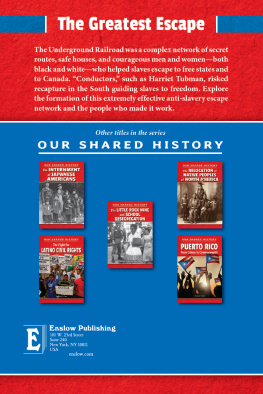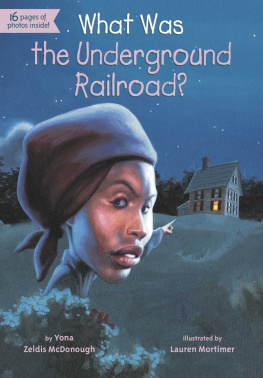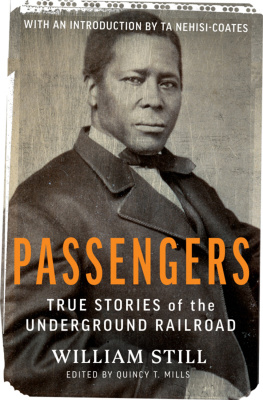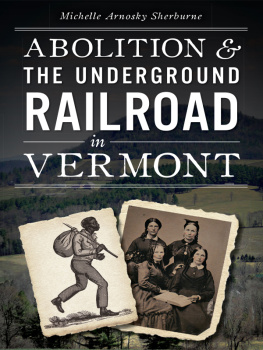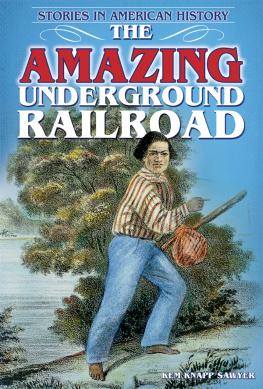

For my wife, Suzanne, whose help and encouragement proved to be invaluable in writing this book.
Copyright 2004 by Stackpole Books
Published by
STACKPOLE BOOKS
5067 Ritter Road
Mechanicsburg, PA 17055
www.stackpolebooks.com
All rights reserved, including the right to reproduce this book or portions thereof in any form or by any means, electronic or mechanical, including photocopying, recording, or by any information storage and retrieval system, without permission in writing from the publisher. All inquiries should be addressed to Stackpole Books.
Printed in the United States of America
10 9 8 7 6 5 4 3 2 1
FIRST EDITION
Cover design by Caroline Stover
Back cover illustration: A Bold Stroke for Freedom. Library of Congress
Maps by Kevin and Katie Switala
Library of Congress Cataloging-in-Publication Data
Switala, William J.
Underground railroad in Delaware, Maryland, and West Virginia / by William J. Switala.1st ed.
p. cm.
Includes bibliographical references (p. ) and index.
ISBN 0-8117-3143-X
1. Underground railroadMiddle Atlantic States. 2. Underground railroadWest Virginia. 3. Fugitive slavesMiddle Atlantic States. 4. Fugitive slavesWest Virginia. 5. DelawareHistory1775 1865. 6. MarylandHistory1775 1865. 7. West VirginiaHistoryTo 1950. I. Title.
E450 .S98 2004
973.7'115dc22
2003023456
eBook ISBN 9780811749602
PREFACE
P rior to the American Civil War, many black people enslaved in the South found their condition so intolerable that they decided to make an attempt to become self-emancipated. They did this by fleeing their masters and going to Northern states, or to Canada, where slavery did not exist. To achieve this goal, they used an escape system known as the Underground Railroad. The term does not refer to any actual railway system that carried runaway slaves to the North via trains, but rather to a loosely knit network of routes and individuals who aided the freedom seekers in their quest. These helpers were men and women, both white and black, rich and poor, educated and not educated, who, driven by conscience, felt strongly that slavery was an evil and that helping fugitives escape was the morally right thing to do.
The goal of the self-emancipators was to reach a place where they would be free. For some, this meant blending into the existing black populations of Northern free states; for others, it meant traveling all the way to Canada. In the eastern part of the country, New Jersey, Pennsylvania, and Ohio were the primary destinations of runaways, whether they wanted to blend into existing populations or travel on to Canada. Though some also came from Georgia, the Carolinas, and Virginia, most of the enslaved people escaping from their bondage came to these destinations basically from Delaware, Maryland, and the western part of Virginia, later to become the state of West Virginia. This book is devoted to the examination of the Underground Railroad systems as they operated in these three border states.
Many books have been written about the Underground Railroad, but only a few of them deal with Delaware, Maryland, and West Virginia. The earliest and most comprehensive of these works is The Underground Railroad: From Slavery to Freedom, written in 1898 by Wilbur Siebert. Siebert devotes some of his book to a discussion of the routes and individuals active in the Underground Railroad movement in these three states. He also includes a comprehensive map of the routes of this escape system covering the entire United States. However, a number of the routes he depicts running through these three states are incomplete. More modern research has shown that there were routes in existence that Siebert does not mention at all. Much of his research is based on two earlier works that covered parts of Delaware and Maryland: William Stills The Underground Railroad: A Record of Facts, Authentic Narratives, Letters, &c. (1872) and Dr. Robert C. Smedleys History of the Underground Railroad in Chester and the Neighboring Counties of Pennsylvania (1883). While these two works are still valuable primary resources, they leave the reader with the impression that the Underground Railroad was operated primarily by white Quakers, with the occasional help of blacks and people of other faiths. The Underground Railroad, written by Charles Blockson in 1987, has chapters devoted to Delaware, Maryland, and West Virginia and goes a long way toward showing that free blacks played a much larger part in the system than previously thought. Finally, the 1996 work by William H. Williams, Slavery and Freedom in Delaware, 16391865, gives a very accurate picture of how the Underground Railroad worked in northern Delaware. Conspicuously missing are any comprehensive works dealing with West Virginia.
The purpose of this book is to expand and enhance the coverage of this topic, in several different ways. First, this work contains more detailed and up-to-date maps of the Underground Railroad routes running through Delaware, Maryland, and West Virginia than are found in Siebert. It also provides information on modern roads that have been built over the routes, thus enabling the modern student of this subject to retrace certain escape paths. The book gives a more in-depth treatment of the impact that geography, transportation systems, free blacks, and the members of other religious congregations in addition to the Quakers had on the operation of the Underground Railroad networks in these three states. To accomplish this, I conducted research using topographic maps; old railroad, highway, and county maps from the nineteenth century; and demographic information gleaned from U.S. censuses taken from 1790 to 1860. The more recent discoveries of many county and local historical societies in the three states also were reviewed and included in this study.
Most of the research for this work was conducted at the Gumberg Library at Duquesne University, the Hillman Library at the University of Pittsburgh, through the on-line services of the Fisher Library at the University of Virginia, the Friends Historical Library at Swarthmore College, and the Library of Congress. In addition to these library sources, I also made use of private collections of papers related to this topic and other original accounts of slave escapes.
Special thanks are due to several people who provided me with valuable information and assistance in researching and writing this book. I thank my son Kevin Switala and his wife, Katie, for the maps they drew for this book, and for their aid in researching the Underground Railroad in Delaware. I am indebted to G. Craig Caba, a historian in Gettysburg, and Professor Ronald Palmer, of George Washington University, for their references and sage advice concerning the treatment of the system in Maryland. I also thank Patrick Trimble, a historian from Fayette County, Pennsylvania, for his guidance and help in exploring the Underground Railroad in West Virginia. Finally, special thanks must be accorded to Kyle Weaver, my editor at Stackpole Books. It was due to his suggestions, encouragement, and skillful editing that this work, as well as my previous book, Underground Railroad in Pennsylvania, were conceived and saw the light of day.



